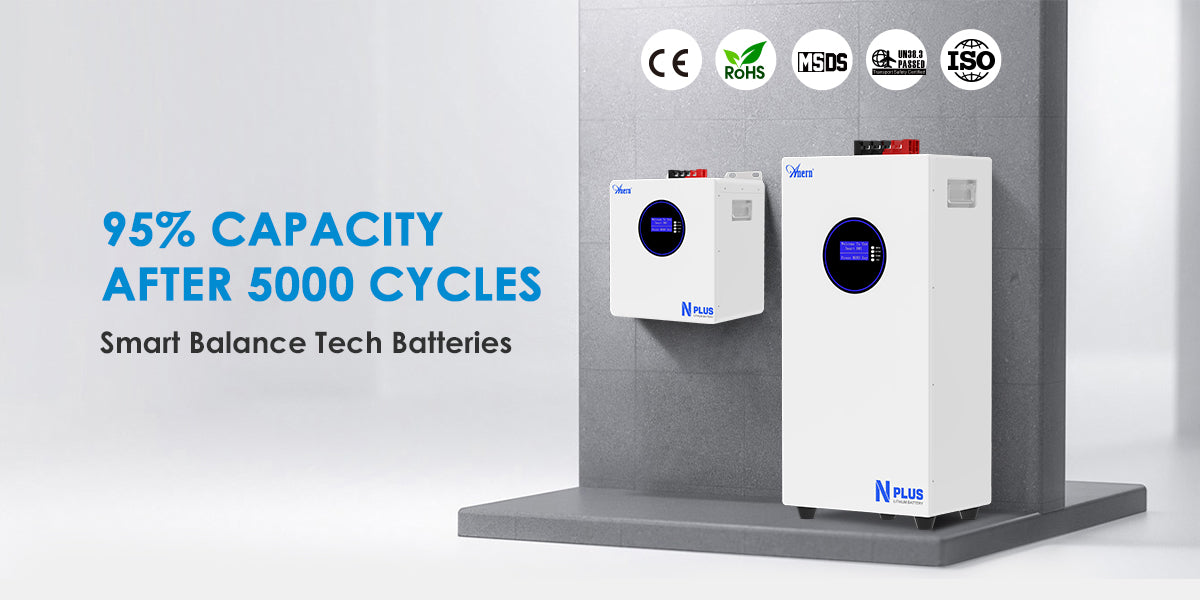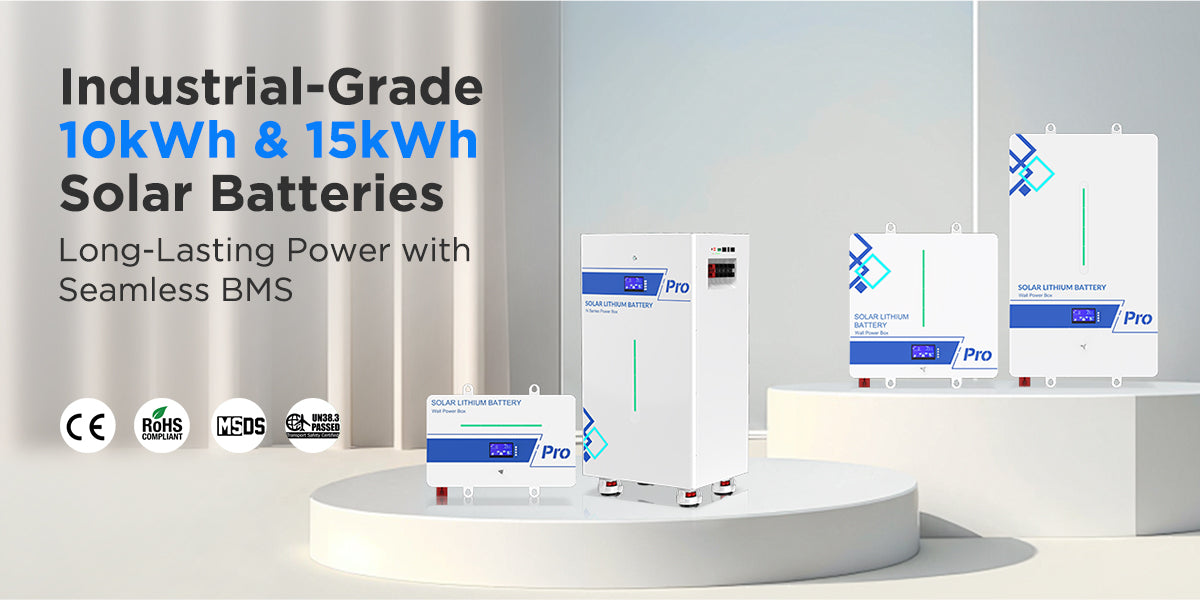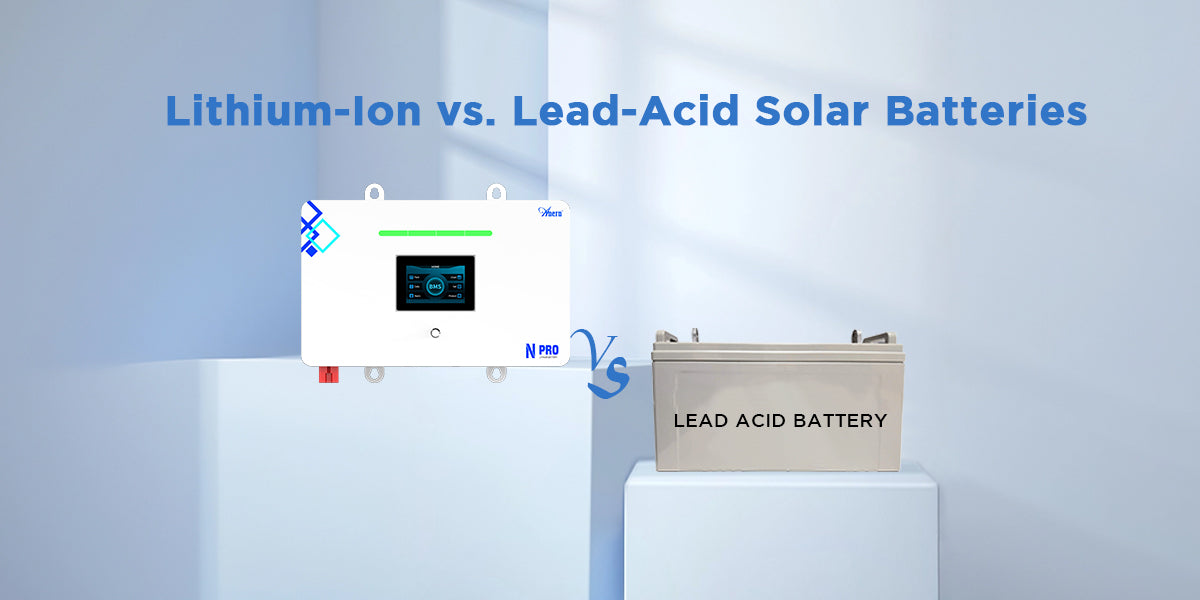Solar panels collect energy. But where does that energy go? A lithium-ion battery stores it so your home can use it later, at night, during a storm, or during a blackout. If you want reliable solar power, you need to understand your battery.
Why Choose Lithium-Ion?
Lithium-ion batteries are now the top pick for home solar systems. Older options like lead-acid or gel batteries still exist, but lithium-ion offers clear upgrades in almost every area.
More Power in Less Space
Lithium-ion cells store more energy per kilogram. This is called energy density. Most lithium batteries offer around 150–200 Wh/kg. Lead-acid batteries average just 30–50 Wh/kg. This means a lithium battery can give the same power with one-third the size and weight. For homes with limited indoor space or wall-mount needs, this helps a lot.
Longer Life
A good lithium-ion battery often lasts 10 to 15 years. Some reach 6,000 cycles or more with daily charging. In contrast, lead-acid batteries may need replacement after 500–1,200 cycles. A longer life means fewer replacements and better long-term value.
High Efficiency
Lithium-ion batteries usually have a round-trip efficiency of 90–95%. This means if you charge with 10kWh of solar energy, you can use around 9.5kWh. Lead-acid often loses 15–20% during each cycle. Over time, higher efficiency saves more energy.
Deeper Discharge Without Damage
Lithium-ion allows deeper use of stored energy without shortening its life. Most can safely reach 90% depth of discharge (DoD). Lead-acid batteries drop in lifespan if used below 50%. So, even if both are labeled as “10kWh,” the usable energy is much higher for lithium.
Faster Charging
Lithium-ion accepts a higher charge current. This helps absorb daytime solar power more quickly, especially when sunlight hours are limited. Some batteries can charge from 20% to 80% in under an hour.
Low Maintenance
No water topping. No acid level checks. No equalizing charge. Lithium-ion is sealed and managed electronically through a smart battery management system (BMS), which controls heat, voltage, and current.
For anyone building or upgrading a solar system, lithium-ion offers clean power, smart control, and long service in a compact form.

Assess Your Energy Storage Needs
Before buying a battery, you need to understand how much energy your home actually uses and how much you want to store.
1. Check Your Power Usage (kWh per Day)
Look at your monthly electric bill. Divide the total kilowatt-hours by the number of days in the month. That’s your daily use. For example, if you used 900kWh in 30 days, your daily average is 30kWh.
2. Decide What You Want to Back Up
Full backup: You want power for your entire home. You’ll need to cover your base load (appliances always running) and peak loads (appliances running at the same time).
Partial backup: You only need energy for essentials like your fridge, lights, Wi-Fi, and medical equipment. This could cut your needs in half or more.
3. Think About Backup Duration (Days Without Sun)
Some people want one night of backup. Others want 2–3 days for weather events. Multiply your daily usage by the number of backup days you want. A 10kWh daily use over 2 days means a 20kWh battery.
4. Know Your Solar Panel Output
Solar panels may be rated at 5kW, but output depends on your location and weather. A 5kW array might give 20kWh per day in sunny areas, but only 12–15kWh in cloudy regions. Ask your installer for real-world numbers.
Once you know your energy goals, compare them to your solar system’s output. Then pick a battery size that supports your usage pattern without going too far over or under.
Match Battery Capacity to Your Solar System
Now that you know how much power you use and want to store, it’s time to choose a battery that fits.
-
Start with your average nighttime use. Multiply it by 1.2 for a safety margin. Example:
- Night use = 6kWh
- 6kWh × 1.2 = 7.2kWh → A battery with 8 to 10kWh will cover it well.
- Adjust for Solar Production. Your battery must charge fully from your solar panels. If your array makes 20kWh a day, a 10–15kWh battery is a common match. Don’t oversize too much, or energy may go to waste.
- Think Ahead. If you plan to add an EV, HVAC system, or more panels later, look for a battery that can grow. Some systems let you add extra modules over time.
- Factor in Climate and Appliance Load. Cold homes often need more heating. Hot homes need more air conditioning. Let your real power use guide your final choice. If unsure, a solar expert can help match your system to your lifestyle.
Beyond Capacity: Lifespan, Cycles, and Safe Energy Use Matter
Battery size is important, but how long it works and how much energy it gives over time matter just as much. Here are three numbers that tell you how strong and durable a lithium-ion battery really is:
| Metric | What It Means | Typical Value | Why It Matters |
| Cycle Life | How many full charges and discharges the battery can handle before it degrades | 3,000 to 6,000 cycles | One cycle per day gives 8–16 years of useful life |
| Depth of Discharge (DoD) | How much of the battery’s energy you can safely use each time | 80% to 95% | Higher DoD means more usable energy per cycle; e.g., 9kWh from a 10kWh battery |
| Throughput | Total energy delivered across the battery's lifetime | 30,000 to 50,000+ kWh | Multiply usable capacity by cycles to understand the total long-term energy value |
Also, check the warranty terms. Most brands promise either 5-8 years or a fixed number of cycles, whichever comes first. Some also list a maximum throughput number. Pick a battery with clear numbers and strong coverage.
System Synergy: Matching the Brain and the Heart
A battery cannot work alone. It must work well with other parts of your solar system. The two most important parts to check are:
Solar panels send out DC power. Your home uses AC power. The inverter turns one into the other. But not every inverter works with every battery. The voltage must match. The inverter must also know how to charge and manage your lithium battery. Many newer models are made to work together but always double-check.
The BMS is the brain of the battery. It controls how fast the battery charges and how deep it discharges. It also protects the battery from too much heat or stress. A smart BMS will talk to the inverter and share real-time data. This helps avoid damage and improve efficiency.
Always check compatibility lists from the battery or inverter maker. Even if the battery and inverter are from different brands, they may still work well together—if they are tested and approved. Some batteries also come with their own inverters built-in. These systems are often easier to set up and manage.
Daily Use: Easy Habits That Keep Your Battery Strong
You don’t need to think about your battery every day. But a few simple habits can help it work better and last longer:
- Check the State of Charge (SoC). This tells how full or empty your battery is. Try to stay in the middle range most days—between 20% and 90%. Going all the way to 0% or 100% often may shorten its life.
- Watch the Temperature. Lithium-ion solar batteries like stable temperatures. Ideal range is 32°F to 113°F (0°C to 45°C). Too hot or too cold can reduce performance or cause faster aging. If you live in a hot area, keep the battery in a shaded indoor place.
- Set the Right Use Mode. Some systems let you pick how to use your power. You can use solar power during the day (self-use), or save it for the evening (backup). You can also set rules like “only charge during the day” or “keep at least 30% stored.” These modes help the battery last longer.
- Avoid Full Discharge Too Often. Even though lithium-ion can go deep, going to 0% every day is not ideal. Try to stop at 10–20% if possible. This helps stretch the number of cycles you get from your battery.
Most systems have a screen or an app. These tools show battery level, energy flow, and temperature. Use them to stay informed, even if you don’t touch the system every day.
Installation Insights: Safe Setup Starts at Home
A great battery can only do its job with a safe and stable setup. Installing it right is key. You need to keep in mind:
- Pick a Good Location. The battery should stay dry and cool. Avoid placing it in a garage with oil fumes or next to a heater. Some systems allow outdoor use, but they still need a cover or weather-safe box.
- Leave Room for Airflow. Batteries can warm up while working. They need space around them to cool down. At least a few inches of space on each side is a good rule.
- Mount It Securely. Some batteries are made to stand on the floor. Others hang on the wall. Either way, they must be steady. Shaky or tilted batteries can wear out faster or even become dangerous in rare cases.
- Use Proper Wires and Fuses. The battery must connect to the inverter and home panel using the right cables. These must handle the current safely. A licensed installer will pick the correct gauge and install breakers or fuses.
- Do a Full System Test. After setup, the installer should run a test. They will check charging, discharging, and communication between the inverter and battery. Some brands also need remote setup or software pairing.
Never skip professional installation. It protects your home, your system, and your warranty.
Long-Term Care: Simple Checks for a Longer Life
Lithium-ion batteries are low-hassle, but not no-hassle. A quick check every few weeks can catch problems early and keep the system running well.
- Glance at the battery. Are the lights normal? Any strange smells or swelling? Is the screen or app working right? Catching small issues early can prevent bigger ones.
- Use a soft cloth to wipe the surface. No spray cleaners. Keep pets, boxes, and sharp items away from the battery.
- Don’t stack items around the battery. Blocked airflow can trap heat and reduce performance.
- Some batteries come with smart apps. These apps may get updates. Sometimes, updates add safety tools or make charging smarter.
- Every brand has its own tips. Following these tips helps keep your battery working well and your warranty active.
Making the Right Choice: Your Final Checklist for Solar Battery Success
Let’s recap the key points before you choose your lithium-ion battery:
- Look at daily energy use and backup goals.
- Match battery size to your solar panel output and home use.
- Check cycles, DoD, and warranty terms.
- Make sure your battery works with your inverter and BMS.
- Keep your battery in the right charge range and temperature.
- Monthly checks and light cleaning go a long way.
A good battery can power your home for many years. With smart use and careful setup, your solar system will stay strong, even when the grid goes dark.





Leave a comment
All comments are moderated before being published.
This site is protected by hCaptcha and the hCaptcha Privacy Policy and Terms of Service apply.